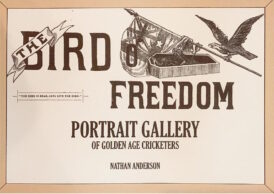The Bird O’ Freedom Portrait Gallery of Golden Age Cricketers
Martin Chandler |Published: 2024
Pages: 53
Author: Anderson, Nathan
Publisher: The Cricket Press Pty Ltd
Rating: 4 stars

I wonder how many Australians have heard of Bird O’Freedom? As an Englishman the name certainly meant nothing to me when I first opened this one, although I now know that, starting life in 1889 as The Dead Bird, it was a modest journal that was published between 1891 and 1896. At that point it was subsumed into The Arrow, which in turn became Referee, before finally disappearing from the newsstands in 1939.
The masthead of the original Dead Bird proclaimed that it was devoted to sport and the drama, and for the purposes of this splendid tribute from Nathan Anderson its main feature was its Portrait Gallery which, over those few years, featured 26 cricketers, all but one, Drewy Stoddart, being Australian.
All 26 Portraits are reproduced in the book, but as interesting as any of them is the first chapter which explains the history of Bird O’ Freedom. Sadly not too much of its non-sporting content is referenced, so it is difficult for someone who has never seen a complete copy to describe it, but it seems to have been not unlike a Victorian version of the present day satirical magazine, Private Eye. Certainly Bird O’Freedom was, like the Eye, no stranger to the law courts and, in a man called Daniel O’Connor, had its own James Goldsmith. O’Connor, like Sir Jimmy a century later, landed the occasional punch on the Bird/Eye but ultimately ended up having bitten off more than he could chew.
Anderson has also, before getting on to the main course, produced a series of profiles of the contributors to ‘The Bird’. They sound like an interesting group of people, despite none of them achieving lasting fame, although to hardened cricket bibliophiles the name of JC Davis will be a familiar one.
As far as the profiles themselves are concerned all are accompanied by a drawing of the individual concerned. There is certainly something of the caricature about these, but they are not entirely in that style. As to the content of the narrative that is certainly of its time. There is humour lurking, and a real attempt to portray the characters of the men involved rather than study their playing records. A good example is this extract from the profile of Sid Gregory, who was 24 at the time it appeared.
Sid Gregory is, perhaps the fastest runner amongst Australia’s First Class cricketers. He has never been known to say an ill-word of anyone, and if an umpire chisels him out he does not fume and call him a bally cheat, but walks off like the little man he is. Sid, like all the Gregorys, is fond of his pipe, and has already evinced an inclination towards a failing of the family – the development of a portly body, due to good living and a happy temperament. Sid Gregory has our kindest wishes, one of which is that he leaves that back cut alone, when the ball pitches between wind and water on the off side.
Not all of those profiled played Test cricket, and a number of those who did are not men whose names resonate more than a century later, so Anderson’s chapter that looks briefly at what became of each of those profiled is a particularly worthwhile exercise.
There are a few adjectives that can be used to describe The Bird O’ Freedom Portrait Gallery of Golden Age Cricketers, and quirky, eclectic, unconventional and offbeat all spring to mind, but above all it is an entertaining period piece and, produced to the usual high standards of this publisher, well worth investing in. Copies are available from Roger Page






Leave a comment